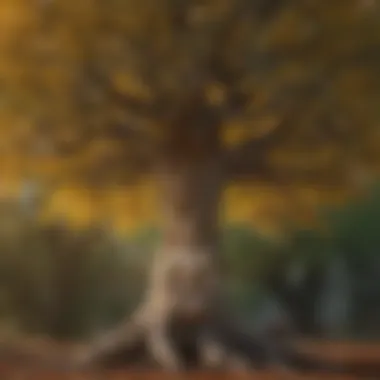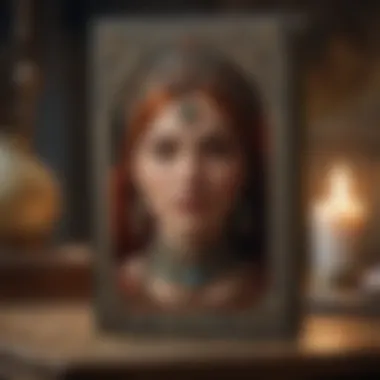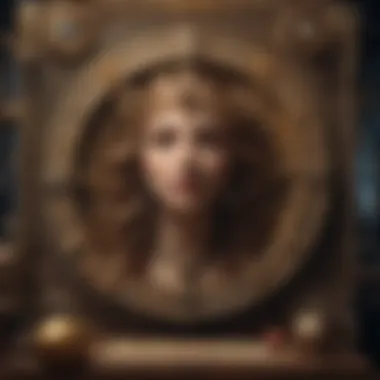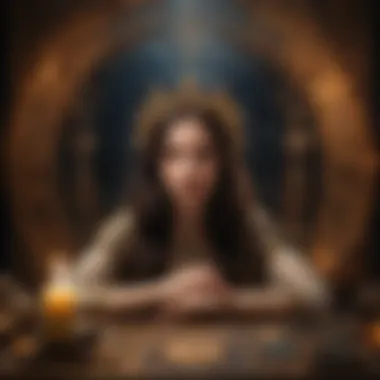Exploring the Synergy of Kabbalah and Tarot


Intro
The study of Kabbalah and Tarot reveals a complex layering of spiritual traditions. Each system embodies deep symbolism and a quest for understanding the self and the universe. This article explores their interconnections, examining how these frameworks can complement each other. Both Kabbalah and Tarot provide distinct insights and pathways toward spiritual growth, thus fostering a greater self-awareness.
Kabbalah, rooted in Jewish mysticism, delves into the nature of divinity, creation, and the soul’s journey. Tarot, with origins in card divination, serves a similar purpose but through visual symbolism and psychological archetypes. When combined, they facilitate a richer perspective on life's circumstances.
Throughout this narrative, we will dissect essential concepts, the significance of numerical codes, and the pathways to personal insight through these mystical practices. We aim to present a cohesive understanding, engaging both seasoned practitioners and newcomers alike.
Understanding the Zodiac
Overview of Zodiac Signs
The Zodiac consists of twelve signs, each corresponding to a segment of the celestial sphere. These signs represent various archetypes that influence personality traits and life events. They are integral in both Kabbalistic thought and Tarot by linking cosmic energies to individual experiences. The signs include Aries, Taurus, Gemini, and others, each holding specific meanings and implications for those born under them.
Sign Traits and Characteristics
Each zodiac sign embodies unique characteristics. For instance, Aries is often associated with boldness, while Pisces may symbolize intuition and emotional depth. Understanding these traits enhances one's practice in Tarot and Kabbalah, as they connect closely to numerology and the different paths of the Tree of Life.
- Aries - Courageous and pioneering
- Taurus - Practical and reliable
- Gemini - Communicative and adaptable
- Cancer - Nurturing and intuitive
- Leo - Confident and expressive
Elemental Qualities
The Zodiac signs are grouped into four elemental categories: fire, earth, air, and water. Each element conveys a specific energy pattern that further embodies the traits of the signs within it. This elemental quality can inform one's understanding of how Tarot cards resonate with personal experiences.
- Fire: Aries, Leo, Sagittarius
- Earth: Taurus, Virgo, Capricorn
- Air: Gemini, Libra, Aquarius
- Water: Cancer, Scorpio, Pisces
Astrological Insights
Current Astrological Trends
Astrology provides insight into current celestial events that can influence our lives. Factors such as retrogrades, eclipses, and planetary alignments often affect emotional states and decision-making. Connecting these trends with cards drawn from Tarot can offer powerful revelations.
Influence of Celestial Events
Celestial events bring different energies into play. For instance, a Mercury retrograde may suggest reflection and reassessment, while a full moon can symbolize completion and release. In combination with Kabbalistic ideas, these influences help to frame one's spiritual inquiries.
How to Interpret Your Birth Chart
The natal chart serves as a personalized cosmic map, revealing the positions of celestial bodies at the time of one's birth. By examining the houses, planets, and aspects, individuals can gain insight into their life path and purpose. This understanding can be synergized with the Tarot by using the cards to explore specific aspects of the chart.
Horoscope and Predictions
Monthly or Weekly Forecasts
Forecasts offer predictions based on current astrological influences. By recognizing trends within your chart, you can map key times for reflection or action. Incorporating insights from Tarot cards during these readings adds depth and context, enhancing the interpretative process.
Personalized Horoscope Reading
A personalized horoscope reading goes beyond general predictions. It considers specific natal chart placements to provide tailored guidance. Combining this with a Tarot reading can illuminate challenges and opportunities pertinent to one’s path.
Compatibility Readings based on Zodiac signs
Understanding compatibility through Zodiac signs can illuminate interpersonal dynamics. It reveals how energies between individuals interact and whether they harmonize or clash. Integrating Tarot readings in this context can provide further clarity regarding relationship strengths and potential hurdles.
“Kabbalah and Tarot, when understood as a cohesive pair, enhance not only self-knowledge but also connect the practitioner to a greater cosmic understanding.”
Engaging with both Kabbalah and Tarot can offer profound insights into the nature of existence and individual experience. These systems, while distinct, resonate deeply with shared themes of interaction, personal growth, and self-discovery.


Intro to Kabbalah and Tarot
The exploration of Kabbalah and Tarot reveals a rich tapestry woven with threads of mysticism and spirituality deeply rooted in human desire for understanding. This section serves as an entry point into the profound dynamics of these two systems, clarifying their definitions, historical contexts, and significance. Both modalities offer frameworks that delve into the intricacies of existence, the universe, and personal identity. Thus, understanding Kabbalah and Tarot opens avenues for deeper introspection and enriched spiritual practices.
Defining Kabbalah
Kabbalah is often described as a mystical aspect of Judaism. It emphasizes understanding the spiritual universe and our place within it. Central to Kabbalah is the concept of the Ten Sefirot, which represent divine attributes and the aspects of God through which the universe interacts with humanity. Each Sefirah is viewed as a tool for understanding not only divine forces but also human psychology.
Kabbalistic teachings often emphasize direct experiential understanding of the divine. This is achieved through study, meditation, and sometimes through formal religious practices. Texts like the Zohar provide deep insight into these teachings, addressing intricate matters of creation, existence, and the path of the soul.
Defining Tarot
Tarot consists of a deck of cards, traditionally 78, used for divination, personal insight, and spiritual growth. Each card holds symbolic meanings, often rooted in archetypal wisdom. The cards are divided into the Major Arcana and the Minor Arcana while representing different life themes and experiences. The Major Arcana is typically regarded as more significant, featuring cards such as The Fool, The Magician, and The High Priestess.
Using Tarot extends beyond simple fortune-telling; it is a tool for self-reflection, allowing individuals to tap into their subconscious. The cards facilitate exploration of personal dilemmas, encourage introspection, and offer insights into various aspects of life.
Historical Context of Both Practices
Understanding the historical backdrop enriches our comprehension of both Kabbalah and Tarot. Kabbalah emerged in the 12th century in Provence, France, influenced by earlier Jewish thought and mystical traditions. Over time, it integrated elements from Neoplatonism, Gnosticism, and other philosophical systems. This blending made Kabbalah accessible not only within Judaism but also to those outside it, deepening its impact on Western esotericism.
Conversely, Tarot's origins are more ambiguous. Initially emerging in the 15th century as a card game in Italy, it evolved into a tool of divination in the late 18th century. The association with mysticism grew as practitioners sought to explore deeper layers of meaning within the cards. The synergy between Tarot and Kabbalah began to take shape during this period, leading practitioners to draw correlations between the two systems. This historical interplay adds layers of significance to their combined use in spiritual practice.
In summary, the relationship between Kabbalah and Tarot extends beyond definitions. Their proximity in historical development has fostered a mutual growth that serves practitioners aiming for deeper spiritual insight. Understanding their individual and collective histories provides a solid foundation for exploring their synergies, which will be elaborated further in this article.
The Fundamentals of Kabbalah
Understanding the fundamentals of Kabbalah is essential to grasping its interplay with Tarot. Kabbalah offers a profound framework through which spiritual realities can be interpreted. The insights gained from studying Kabbalah can lead to personal transformation. At the core of Kabbalistic thought are concepts that elucidate one's place in the universe and the nature of divinity.
The Ten Sefirot
The Ten Sefirot form the basis of Kabbalistic cosmology. They represent the attributes or emanations through which the divine interacts with the world. This system gives a structured interpretation of the universe's inner workings. Each Sefirah corresponds to specific qualities and principles that govern both the physical and spiritual realms.
The Ten Sefirot are:
- Keter (Crown)
- Chokhmah (Wisdom)
- Binah (Understanding)
- Chesed (Kindness)
- Gevurah (Severity)
- Tiferet (Beauty)
- Netzach (Eternity)
- Hod (Glory)
- Yesod (Foundation)
- Malkuth (Kingdom)
Grasping how each Sefirah reflects different aspects of human experience extends beyond mere academic knowledge. It connects deeply to emotional and psychological understanding. The Sefirot serve as a map to navigate personal challenges, illuminating pathways toward growth and understanding.
The Tree of Life
The Tree of Life is a central symbol in Kabbalah. It visually represents the Ten Sefirot and their relationships. Each Sefirah is linked by pathways, forming a comprehensive matrix. This structure elucidates how divine energy flows and interacts within both individual and collective consciousness.
Understanding the Tree of Life can help individuals relate their personal experiences to larger spiritual truths. By examining one's life through the lens of the Tree of Life, deeper insights about challenges and aspirations can emerge. This process often leads to a more integrated approach to personal development.
Key Concepts in Kabbalistic Teachings
Kabbalah encompasses several core concepts that are fundamental to its teachings. Among these are:
- Ein Sof: The infinite or unknowable aspect of divinity. It represents the source of all creation.
- Tzimtzum: The process of contraction through which God creates a space for the universe.
- Shvira: Refers to the breaking of vessels, which speaks to the discord in creation and the need for rectification.
These elements contribute to a broader understanding of Kabbalistic philosophy. They explore the interplay between the divine and the material world. Integrating these teachings can yield transformative insights. These insights can have profound implications for one's spiritual practice, particularly when fused with Tarot.
Kabbalah provides a structure that enhances one's comprehension of the cosmic order, which is crucial for anyone seeking to deepen their spiritual practice.
In summary, understanding the fundamentals of Kabbalah is not just an academic venture. It is a pathway to profound insights that resonate deeply when combined with the practices of Tarot. What unfolds through this integration can illuminate one's spiritual journey in a unique, enriching way.
The Structure of Tarot
The structure of Tarot serves as a foundational element for understanding its significance in spiritual and esoteric practices. This system divides the Tarot deck into two main categories: the Major Arcana and the Minor Arcana. Each category has its distinct purpose and meaning, but they are interconnected, enhancing the overall interpretive experience of the cards. Grasping the structure aids users in utilizing Tarot as an effective tool for divination, self-discovery, and personal growth.


Major Arcana and Minor Arcana
The Major Arcana consists of 22 cards, often referred to as the tarot's 'trump' cards. They encapsulate profound themes and experiences that represent significant life events or spiritual lessons. The Minor Arcana, on the other hand, comprises 56 cards divided into four suits, similar to a traditional playing deck. Each suit corresponds to specific aspects of daily life, emotions, actions, and thoughts.
The core difference lies in their impact on a reading; while the Major Arcana captures larger life themes, the Minor Arcana offers insights into everyday dynamics. For instance, drawing a Major Arcana card like The Fool may indicate a significant new beginning, whereas a Minor Arcana card like the Eight of Cups might suggest personal feelings regarding everyday situations.
This distinction is vital for both beginners and seasoned practitioners, as it allows them to decode the messages offered through Tarot with more clarity and context.
The Significance of Archetypes
Archetypes are elemental patterns, rooted in the collective unconscious, that manifest universally across humanity’s narratives. Each card in the Tarot deck embodies an archetype, serving as a bridge between conscious understanding and subconscious intuition. By exploring these archetypes, tarot practitioners can access deeper layers of meaning. For example, the archetype of The Empress represents abundance and nurturing, resonating with the personal connections and creative pursuits of the querent.
Recognizing archetypes also facilitates a process known as projection, in which individuals relate their own life experiences to the universal themes represented by the Tarot. This adds a rich layer of personal significance to readings and can illuminate pathways of growth and emotional insights.
Tarot as a Tool for Self-Reflection
Utilizing Tarot for self-reflection involves drawing cards and interpreting their meanings in relation to one's own life circumstances. This method encourages personal exploration and introspection. It provides a safe space for individuals to confront inner thoughts and feelings, promoting emotional intelligence.
When engaging with Tarot as a self-reflection tool, several practices can enhance the experience:
- Daily Draws: Selecting one card each day can set the tone for introspection and mindfulness.
- Themed Spreads: Using themed spreads, such as those focused on relationships, career, or personal challenges, allows for targeted insights.
- Journaling: Documenting insights and feelings related to drawn cards fosters ongoing personal development and clarity.
Intersections Between Kabbalah and Tarot
The exploration of the intersections between Kabbalah and Tarot reveals a rich tapestry of symbolic and philosophical connections. Understanding these intersections enhances both systems, offering greater insights into personal and spiritual development. The synergy between Kabbalah and Tarot is vital not only for practitioners but also for those seeking deeper meaning in the spiritual domain. This section focuses on three main aspects: the correspondences between the Sefirot and Tarot cards, how Tarot can help in exploring Kabbalistic concepts, and the significant role of numerology in both systems.
Correspondences Between the Sefirot and Tarot Cards
The Sefirot represent a complex structure in Kabbalistic thinking, consisting of ten attributes or emanations through which the divine creates and sustains the universe. Each Sefirah corresponds to specific themes and archetypes, which are mirrored in the Tarot cards. For instance, the first Sefirah, Keter, often links to the Fool card in Tarot, symbolizing potential and beginnings. Another example is Tiferet, associated with the card of the Lovers, emphasizing beauty, harmony, and the balance of dualities.
Understanding these correspondences allows practitioners to create a dialogue between the two systems, illustrating how they can inform and deepen each other’s meanings. By analyzing the relationship between specific Sefirot and Tarot cards, one can gain insights into personal life situations and greater spiritual truths. This interplay helps in navigating one's path, offering clarity and guidance.
Using Tarot to Explore Kabbalistic Concepts
Tarot can be a powerful tool to engage with the complex ideas found within Kabbalah. The symbolic nature of Tarot allows for abstraction and invites interpretation that can mirror Kabbalistic teachings. For example, using Tarot spreads focused on Kabbalistic themes can facilitate exploration of concepts such as balance, union, and divine consciousness. Practitioners can set intentions that align with Kabbalistic ideas to uncover layers of understanding.
For those drawn to mystical traditions, tarot readings inspired by Kabbalistic principles can lead to revelations about their spiritual journey. When users approach card readings with an awareness of these concepts, the insights gained can resonate deeply on both personal and universal levels, making complex ideas more accessible.
The Role of Numerology in Both Systems
Numerology serves as the backbone of both Kabbalah and Tarot, providing a bridge between these systems. In Kabbalah, numbers carry deep significance; they are not merely mathematical but possess spiritual meaning that resonates with Sefirot and the Tree of Life. The study of numbers in Kabbalah can unveil profound insights into a person's life experiences and spiritual lessons.
Similarly, Tarot's structure is heavily reliant on numerology. Each card in the deck has an associated number, which influences its meaning and interpretation. For example, the Empress card is the third card of the Major Arcana, which signifies creation, abundance, and maternal energy.
Integrating numerology can enhance the understanding of both Tarot readings and Kabbalistic meditation. This highlights the significance of numerical values, inviting one to explore the relationship between numbers, archetypes, and spiritual significance. Therefore, synthesizing the numerological aspects of both practices can contribute to a more profound understanding of one’s spiritual development.
The intersection of Kabbalah and Tarot enriches the user's comprehension of both systems, encouraging growth and awareness on multiple levels.
Engaging with these intersections not only deepens personal insight but also builds a bridge toward broader spiritual exploration. By systematically analyzing the correspondences, utilizing Tarot for Kabbalistic concepts, and understanding the power of numerology, one can harness the combined strengths of Kabbalah and Tarot for profound spiritual engagement.
Practical Applications
Understanding the practical applications of Kabbalah and Tarot is crucial for anyone looking to enhance their spiritual journey. Integrating these two rich traditions can provide unique insights and fresh perspectives. The relevance of practical applications lies in their ability to bridge theoretical knowledge with experiential understanding.
When individuals combine Kabbalistic teachings with Tarot readings, they create a holistic approach to introspection and personal growth. This synergy can lead to a more profound comprehension of one's self and the universe. Practical applications include methods and techniques directly usable in daily life, which help in deepening the connection between various spiritual concepts.
Combining Kabbalistic Meditation and Tarot Readings


Combining Kabbalistic meditation with Tarot readings is a compelling practice. Each card in the Tarot deck can serve as a focal point during meditation. For instance, the Major Arcana cards can be linked to specific Sefirot in Kabbalah. This connection allows users to meditate on themes related to wisdom or understanding prevalent in the cards.
Benefits of this combination include:
- Heightened spiritual awareness
- Enhanced clarity in decision-making
- A deeper understanding of personal challenges
Merging these two practices encourages one to reflect on their life in the context of ancient wisdom. Meditation can provide calming insights while Tarot offers guidance, creating a balanced approach to self-discovery.
Developing Personal Tarot Spreads with Kabbalistic Themes
Creating personal Tarot spreads that incorporate Kabbalistic themes can enrich one's practice. Personalization allows practitioners to focus on aspects of their life they want to explore, rooted in Kabbalistic symbolism. For instance, using the Tree of Life as a layout can help visualize energies influencing decisions and prospects in one’s life.
When designing such spreads, consider:
- Selecting Tarot cards that align with specific Sefirot
- Using the layout to reflect personal desires or questions
- Interpreting the cards through a Kabbalistic lens
This approach can deepen the meaning of each card drawn, revealing layers of insights that traditional spreads may not provide. The interplay of these layers fosters deeper emotional processing and spiritual alignment.
Enhancing Intuition Through Symbolism
Tarot and Kabbalah are both steeped in rich symbolism. Enhancing intuition through this symbol system can facilitate personal insights. Each symbol can be viewed not just as a means of divination but as a tool for understanding complex emotional and spiritual states. Practicing the interpretation of symbols, and linking these to Kabbalistic principles, can sharpen one��’s intuitive abilities.
To effectively enhance intuition:
- Regularly study the symbolism behind each Tarot card and Kabbalistic concept
- Record personal insights and feelings associated with specific symbols
- Explore different interpretations and allow personal insight to guide understanding
As individuals engage deeper with these symbols, their intuition can become more finely tuned. This growth leads to a more informed and instinctual approach to challenges and decisions, enhancing both spiritual and worldly understanding.
Integrating Kabbalah and Tarot through practical applications deepens personal insight and fosters spiritual growth.
Benefits of Integrating Kabbalah and Tarot
Integrating Kabbalah and Tarot presents a unique opportunity for deeper exploration of spirituality and personal insight. Each system offers distinct advantages that can complement and enrich the other. This integration encourages a holistic approach to self-discovery, allowing practitioners to navigate their inner worlds with more clarity and understanding.
Deeper Understanding of Self
One of the primary benefits of merging Kabbalah and Tarot is the chance to develop a deeper understanding of oneself. Kabbalistic teachings emphasize the significance of the Sefirot, which represents various aspects of the divine and human experience. When these concepts intersect with Tarot's archetypal imagery, it can lead to profound realizations about personal strengths and weaknesses.
- Introspection: Tarot cards can serve as mirrors, reflecting internal states and helping individuals confront their true selves.
- Symbolism: Each Tarot card carries symbolic weight, connecting with Kabbalistic themes. For instance, the Fool card can connect to the concept of the Ein Sof, the boundless aspect of divinity, representing potential and new beginnings.
- Personal Growth: This introspective process encourages deeper self-awareness, illuminating paths for personal growth and transformation.
Expanded Spiritual Awareness
The intersection between Kabbalah and Tarot can lead to expanded spiritual awareness. Each system offers insights into the spiritual dimensions of existence. By studying their connections, practitioners can gain richer perspectives on their spiritual journeys.
- Holistic Spirituality: Kabbalah teaches about the interconnectedness of all things, illustrated through the Tree of Life. Integrating Tarot, practitioners can visualize spiritual lessons through cards, enriching their understanding.
- Divine Guidance: Tarot readings can act as channels for divine wisdom. Coupled with Kabbalistic principles, this experience may deepen one's sense of connection to higher powers or the universe.
- Intuitive Insight: Combining both systems encourages the development of intuition, allowing for more profound spiritual experiences. This awareness can lead to enlightenment beyond one's initial understanding.
Facilitation of Personal Growth
Personal growth is another significant benefit of integrating Kabbalah and Tarot. Both systems advocate for transformation and evolution, making their union particularly fruitful.
- Self-Improvement Techniques: Kabbalistic meditation techniques can be enhanced by the insights gained from Tarot readings, fostering a more comprehensive framework for self-improvement.
- Practical Applications: Utilizing Tarot spreads inspired by Kabbalistic themes allows for directed explorations into personal challenges, promoting effective solutions and further growth.
- Community Engagement: Embracing these systems together may encourage participation in communities that prioritize esoteric studies, facilitating relationships with like-minded individuals.
The synergy between Kabbalah and Tarot creates a pathway towards deep self-discovery and spiritual enlightenment. By exploring their integration, practitioners can attain a richer understanding of both their inner worlds and the cosmic forces around them.
End
The conclusion of this article holds significant weight in understanding the intricate bond between Kabbalah and Tarot. These systems, although seemingly distinct, share underlying principles that can deepen one's spiritual practice and self-awareness. By drawing attention to their interconnections, we can see how integrating these traditions can enhance personal insight.
Reflections on the Integration of Systems
Reflecting on the integration of Kabbalah and Tarot reveals a profound way to navigate the complexities of spiritual exploration. Practitioners can find themselves embarking on a journey that is both enlightening and transformative. The alignment of Kabbalistic teachings with Tarot readings allows for a more holistic view of the self and the universe. As practitioners engage with both systems, clarity emerges. They can utilize Kabbalistic frameworks, such as the Tree of Life, to better understand the archetypal messages of Tarot cards. In turn, Tarot serves as a practical tool to illustrate and internalize Kabbalistic concepts. This interplay creates a symbiosis that fosters deeper insights.
Future Exploration and Study
The future of exploring Kabbalah and Tarot is ripe with potential. As more people seek to understand these paths, there will be expanded opportunities for study and practice. Researchers and spiritual seekers alike can delve into the vast array of resources available. Academic studies can bring new perspectives on historical and cultural contexts, while practical applications can encourage personal growth. Online communities, such as those on Reddit and Facebook, provide platforms for discussion and sharing of insights. Overall, approaching the relationship between Kabbalah and Tarot with an open mind will yield invaluable discoveries, enriching the spiritual journeys of those who seek them.







